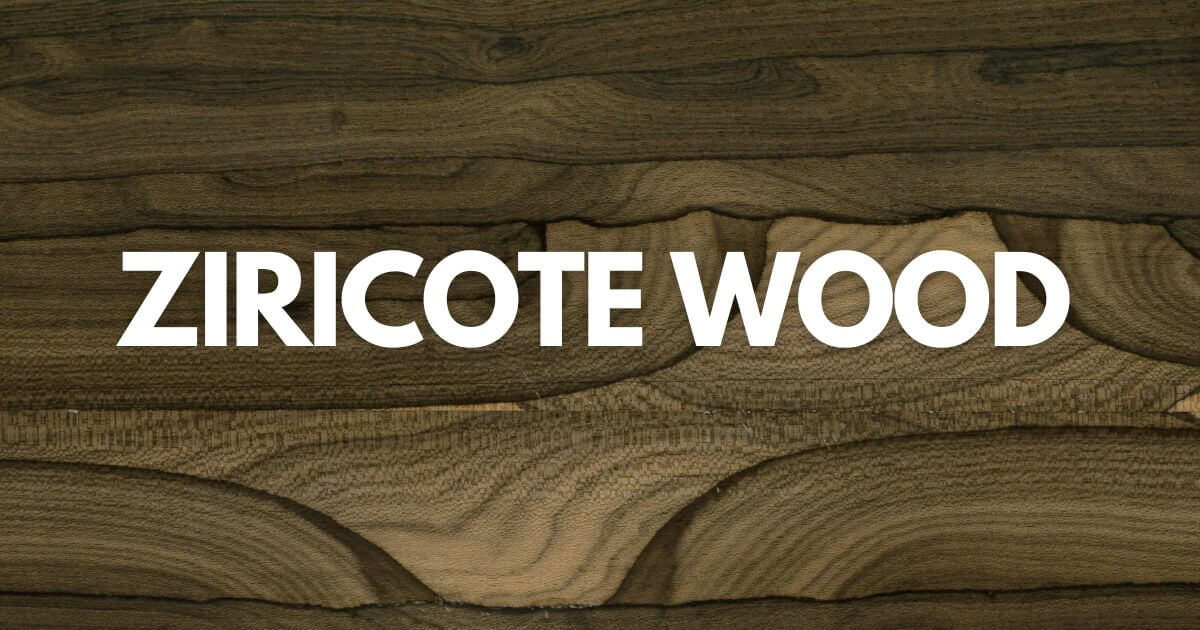What is Ziricote Wood?
Ziricote is one of the most popular hardwoods, native to the tropical region of Central America and Mexico. It is unique for its striking appearance and extreme durability.
Ziricote wood is known for its hardness, density, and stability, making it a popular choice for various applications.
| # | Ziricote Wood |
| Scientific name | Cordia dodecandra |
| Tree Size | 30-70 ft (10-21 m) tall, 2-3 ft (.6-1.0 m) trunk diameter |
| Janka Hardness | 1,970 lbf (8,780 N) |
| Elastic Modulus | 1,585,000 lbf/in2 (10.93 GPa) |
| Crushing Strength | 9,270 lbf/in2 (63.9 MPa) |
| Shrinkage: Radial: | 3.5%, Tangential: 6.7%, Volumetric: 9.8%, T/R Ratio: 1.9 |
| Type | Hardwood |
Uses
Ziricote wood is mainly used to make high-quality furniture, veneer, cabinetry, gunstocks, tools handle, and decorative wooden items. It can also be a better choice for flooring, as it is hard, durable, and less prone to scratches and dents.
Ziricote wood is prized for its tonal qualities and is often used to manufacture high-end acoustic guitars, ukuleles, and other musical instruments.
Appearance
Ziricote wood can be medium to dark brown with light brown or grey streaks. The heartwood of Ziricote is usually dark brown to black with an irregular pattern of lighter and darker streaks or bands, while the sapwood is usually light brown or grey.
Ziricote wood has straight to interlocked grain. Medium to fine texture with a natural luster. Ziricote wood darkens slightly over time due to various factors such as exposure to light, air, and other environmental conditions. Changing color can be slowed down by proper finishing or sealing.
Ziricote Wood Pros and Cons
Ziricote wood is a durable and strong wood species with some limitations, which you should know before using it.
Pros
- Beautiful Appearance: Ziricote wood is known for its attractive appearance, with dark brown or black streaks that make it different from other woods.
- Durable and Rot-resistant: Ziricote is a hard, dense, and stable wood that is resistant to wear, scratches, and dents. It is also naturally resistant to rot and decay.
- Sustainable: Ziricote wood is considered a sustainable option for woodworking.
- Easy to work: Ziricote wood is hard but easily worked with the right tools.
Cons
- Expensive: Ziricote wood costs more than other hardwoods because it is rare, durable, and moisture-resistant. Sometimes it is not readily available.
- Heavy: Due to its high density, it is heavy, which can be difficult during transportation or working with.
- Allergies: Some common allergic problems, such as skin and eye irritation, have been observed when working with Ziricote wood.
Workability
Generally, Ziricote Wood is easy to work with hand and machine tools. It can be difficult due to its hardness and heaviness, but it can be easily done using the right tools.
The Ziricote is very oily, which can make it challenging to finish, but it gives excellent results after finishing. It glues very well with no problem.
Hardness
Ziricote wood has a Janka hardness rating of 1,970 lbf (8,780 N) and an average dried weight of 50 lbs/ft3 (805 kg/m3).
Here is the Janka hardness of some popular wood species with Ziricote to give you an idea of how hard Ziricote Wood is.
| Wood Species | Janka Hardness |
| Black Walnut | 1,010 lbf (4,490 N) |
| Claro Walnut | 1,130 lbf (5,030 N) |
| English Walnut | 1,220 lbf (5,410 N) |
| Bastogne Walnut | 1,250 lbf (5,560 N) |
| Queensland Walnut | 1,670 lbf (7,380 N) |
| Merabu wood | 1,840 lbf (7,620 N) |
| Ziricote Wood | 1,970 lbf (8,780 N) |
| Bocote | 2,010 lbf (8,950 N) |
| Bubinga | 2,410 lbf (10,720 N) |
| Tulipwood | 2,500 lbf (11,120 N) |
Rot-resistant
Ziricote wood is naturally resistant to decay, insects and weathering, making it an excellent choice for use in outdoor applications. The high density and presence of natural oils make it highly resistant to moisture and decay compared to other woods.
Price
Ziricote wood is an expensive species that can cost anywhere from $30 to $60 per board foot. It is sometimes difficult to find in smaller stores, as it is a rare wood known for its unique grain texture.
FAQ
Is Ziricote Wood Waterproof?
Ziricote wood is not entirely waterproof but has excellent resistance to water and moisture. The natural oils of the wood form a protective layer on the surface so that moisture or water cannot easily penetrate the wood.
But, when the wood is exposed to water or humidity for a long time, it can absorb some water and eventually begin to deteriorate.
Therefore, it is essential to do exterior finishing to ensure its longevity and durability. Applying a sealant can help further increase the water resistance of the wood and protect it from damage caused by exposure to water and moisture.
Is Ziricote Wood an Allergic?
Ziricote wood is not known to be a highly allergenic wood species but can cause common problems such as eye and skin reactions when worked. So it would be best if you were careful while working with it.
Is Ziricote Wood Good For Cutting Boards?
Yes, Ziricote Wood can be used as a cutting board. It is hard and moisture-resistant, making it an excellent choice for cutting boards. However, the oil content can make the wood difficult to glue and finish properly, which can be a disadvantage when making cutting boards.
Where is Ziricote Wood Grown?
Ziricote wood is mainly grown in Central America, specifically in Mexico, Belize, Guatemala, and Honduras. It is a tropical hardwood that thrives in hot and humid climates and is commonly found in lowland areas near rivers and streams.
The flowers are produced in clusters from February to May at the ends of many of the Ziricote tree’s branches.

